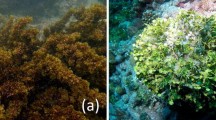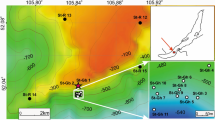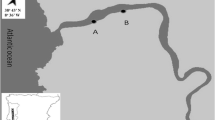Abstract
The fate of the benthic bacterial biomass is a topic of major importance in understanding how soft-bottom environments function. Because of their high abundance, production and nutritional value, benthic bacteria may constitute an important food resource for benthic fauna. The trophic role of bacteria for a nematode community on the Brouage mudflat (Marennes-Oléron-France), dominated by three species: Chromadora macrolaima (64% of the abundance), Daptonema oxycerca (15%) and Ptycholaimellus jacobi (8%), was determined in grazing experiments using 15N pre-enriched bacteria. On intertidal flats, seasonal, tidal and circadian cycles induce strong variations in environmental conditions. Grazing experiments were performed in order to measure the effects of abiotic (temperature, salinity and luminosity) and biotic (bacterial and algal abundances) factors on assimilation rates of bacteria by nematodes. In order to assess simultaneously bacteria and algal assimilation rates, algal abundances were modified adding 13C pre-enriched Navicula phyllepta. Assimilation rate was significantly lower at 5°C; moreover, general trend shows a prominent temperature effect with an optimum around 30°C. Assimilation at salinity 18 was not significantly different from the assimilation at salinity 31. Assimilation was higher under light conditions than in the dark. Above 109 bacteria ml−1, assimilation of bacteria remained unaffected by bacterial abundance. However, assimilation of algae increased with the algal concentration. Nematode kept feeding under conditions of stress, which are typical of the surficial sediment habitat and they appeared to be principally dependent on the algal resource.






Similar content being viewed by others
References
Boucher G (1974) Premières données écologiques sur les nématodes libres marins d’une station de vase côtière de Banyuls. Vie Milieu 23:69–100
Bouvy M (1988) Contribution of the bacterial and microphytobenthic microflora in the energetic demand of the meiobenthos in an intertidal muddy sediment (Kerguelen Archipelago). PSNZI Mar Ecol 9:109–122
Buffan-Dubau E, Carman KR (2000) Diel feeding behavior of meiofauna and their relationships with microalgal resources. Limnol Oceanogr 45:381–395
Carman KR, Dobbs FC, Guckert JB (1989) Comparison of three techniques for administering radiolabeled substrates for trophic studies: uptakes of label by harpaticoid copepods. Mar Biol 102:119–125
Chatterji A, Ansari ZA, Mishra JK, Parulekar AH (1995) Seasonality in meiofaunal distribution on a tropical beach at Balramgari, northwest coast of India. Indian J Mar Sci 24:49–55
Croll NA (1970) The behaviour of nematodes: their activity, senses and responses. Edward Arnold, London
Decho AW (1988) How do harpaticoides grazing rates differ over a tidal cycle? Field verification using chlorophyll-pigment analyses. Mar Ecol Prog Ser 45:263–270
Degré D, Leguerrier D, Armynot du Chatelet E, Rzeznik-Orignac J, Auguet J-C, Dupuy C, Marquis E, Fichet D, Struski C, Joyeux E, Sauriau P-G, Niquil N (2006) Comparative analysis of the food webs of two intertidal mudflats during two seasons using inverse modelling: Aiguillon Cove and Brouage Mudflat, France. Est Coast Shelf Sci 69:107–124
Duncan A, Schiemer F, Klekowski RZ (1974) A preliminary study of feeding rates on bacterial food by adult femals of a benthic nematode, Plectus palustris de Man 1880. Pol Arch Hydrobiol 21:249–258
Fenchel T (1972) Aspects of decomposer food chains in marine benthos. Verh Dtsch Zool Ges 65:14–22
Forster SJ (1998) Osmotic stress tolerance and osmoregulation of intertidal and subtidal nematodes. J Exp Mar Biol Ecol 224:109–125
Gee JM (1985) Seasonal aspects of the relationship between temperature and respiration rate in four species of intertidal harpaticoid copepod. J Exp Mar Biol Ecol 93:147–156
Gerlach SA (1971) On the importance of marine meiofauna for benthos communities. Oecologia 6:176–190
Grewal PS, Wright RT (1992) Migration of Caenorhabditis elegans (Nematod: Rhaabditidae) larvae towards bacteria and the nature of bacterial stimulus. Fundam Appl Nemat 15:159–166
Guarini JM, Blanchard GF, Gros P, Harrison SJ (1997) Modeling the mud surface temperature on intertidal flats to investigate the spatio-temporal dynamics of the benthic microalgal photosynthetic capacity. Mar Ecol Prog Ser 153:25–36
Hamels I, Sabbe K, Muylaert K, Vyverman W (2004) Quantitative importance, composition, and seasonal dynamics of protozoan communities in polyhaline versus freshwater intertidal sediments. Microb Ecol 47:18–29
Heip CHR, Herman P, Coomans A (1982) The productivity of marine meiobenthos. Academia Analecta 44:1–20
Heip CHR, Vincx M, Vranken G (1985) The ecology of marine nematodes. Oceanogr Mar Biol Annu Rev 23:399–489
Héral M, Razet D, Deslous-Paoli JM, Bertome JP, Garnier J (1982) Caractéristiques saisonnières de l’hydrologies du complexe estuarien de Marennes-Oléron (France). Revue des travaux de l’institut des pêches maritimes 46:97–119
Herlory O, Guarini JM, Richard P, Blanchard GF (2004) Microstructure of microphytobenthos biofilm and its spatio-temporal dynamics in an intertidal mudflat (Aiguillon Bay, France). Mar Ecol Prog Ser 282:33–44
Herman PMJ, Vranken G (1988) Studies of the life history and energetics of marine and brackish water nematodes. II. Production, respiration and food-uptake by Monhystera disjuncta. Oecologia 77:457–463
Holling CS (1959) Some characteristics of simple types of predation and parasistism. Can Entomol 91:385–398
Hondeveld BMJ, Bak RPM, van Duyl FC (1992) Bacterivory by heterotrophic nanoflagellates in marine sediments measured by uptake of fluorescently labeled bacteria. Mar Ecol Prog Ser 89:63–71
Jensen KT (1987) Feeding ecology of free-living aquatic nematodes. Mar Ecol Prog Ser 35:187–196
Kelly JA, Honeywill C, Paterson DM (2001) Microscale analysis of chlorophyll-a in cohesive intertidal sediments: the implications of microphytobenthos distribution. J Mar Biol Assoc UK 81:151–162
Kemp PF (1990) The fate of benthic bacterial production. Rev Aquat Sci 2:109–124
Kuipers BR, de Wilde PAWJ, Creutzberg F (1981) Energy flow in a tidal flat ecosystem. Mar Ecol Prog Ser 5:215–221
Legendre L, Rassoulzadegan F (1996) Food-web mediated export of biogenic carbon in oceans: hydrodynamic control. Mar Ecol Prog Ser 145:179–193
Leguerrier D, Niquil N, Boileau N, Rzeznik J, Sauriau PG, Le Moine O, Bacher C (2003) Numerical analysis of the food web of an intertidal mudflat ecosystem on the Atlantic coast of France. Mar Ecol Prog Ser 246:17–37
Leguerrier D, Niquil N, Petiau A, Bodoy A (2004) Modeling the impact of oyster culture on a mudflat food web in Marennes-Oléron Bay (France). Mar Ecol Prog Ser 273:147–162
Lopez G, Riemann F, Schrage M (1979) Feeding biology of the brackish-water Oncholaimid nematod Adoncholaimus thalassophygas. Mar Biol 54:311–318
MacIntyre HL, Geider RJ, Miller DC (1996) Microphytobenthos: the ecological role of the “secret garden” of unvegetated, shallow-water marine habitats. I. Distribution, abundance and primary production. Estuaries 19:186–201
Mariotti A (1982) Apports de la géochimie isotopique à la connaissance du cycle de l’azote. PhD Thesis, Paris, 476 pp
Meyer-Reil LA, Faubel A (1980) Uptake of organic matter by meiofauna organisms and interrelationships with bacteria. Mar Ecol Prog Ser 3:251–256
Moens T (1999) Feeding ecology of free-living estuarine nematodes. An experimental approach. PhD Thesis, 302
Moens T, Bergtold M, Traunspurger W (2006) Feeding ecology of free-living benthic nematodes. In: Eyulaem A, Andrassy I, Traunspurger W (eds) Freshwater nematodes: ecology and taxonomy. CAB International publishing, Cambridge, pp 105–131
Moens T, Herman P, Verbeeck L, M. S, Vincx M (2000) Predation rates and prey selectivity in two predacious estuarine nematode species. Mar Ecol Prog Ser 205:185–193
Moens T, Verbeeck L, de Maeyer A, Swings J, Vincx M (1999a) Selective attraction of marine bacterivorous nematodes to their bacterial food. Mar Ecol Prog Ser 176:165–178
Moens T, Verbeeck L, Vincx M (1999b) Feeding biology of a predatory and a facultatively predatory nematode (Enoploides longispiculosus and Adoncholaimus fuscus). Mar Biol 134:585–593
Moens T, Verbeeck L, Vincx M (1999c) Preservation and incubation time-induced bias in tracer-aided grazing studies on meiofauna. Mar Biol 133:69–77
Moens T, Vierstraete A, Vincx M (1996) Life strategies in two bacterivorous marine nematods: preliminary results. PSNZI Mar Ecol 17:509–518
Moens T, Vincx M (1997) Observations on the feeding ecology of estuarine nematodes. J Mar Biol Assoc UK 77:211–227
Moens T, Vincx M (2000) Temperature, salinity and food thresholds in two brackishwater bacterivorous nematode species: assessing niches from food absorption and respiration experiments. J Exp Mar Biol Ecol 243:137–154
Montagna PA (1984a) Competition for dissolved glucose between meiobenthos and sediment microbes. J Exp Mar Biol Ecol 76:177–190
Montagna PA (1984b) In situ measurement of meiobenthic grazing rates on sediment bacteria and edaphic diatoms. Mar Ecol Prog Ser 18:119–130
Montagna PA (1995) Rates of metazoan meiofaunal microbivory: a review. Vie Milieu 45:1–9
Montagna PA, Bauer JE (1988) Partitioning radiolabeled thymidine uptake by bacteria and meiofauna using metabolic blocks and poisons in benthic feeding studies. Mar Biol 98:101–110
Montagna PA, Blanchard GF, Dinet A (1995) Effect of production and biomass of intertidal microphytobenthos on meiofaunal grazing rates. J Exp Mar Biol Ecol 185:149–165
Nicholas WL, Grassia A, Viswanathan S (1973) The efficiency with which Caenorhabditis briggsae (Rhabditinae) feeds on the bacterium Escherichia coli. Nematologica 19:411–420
Nozais C, Desrosiers G, Gosselin M, Belzile C, Demers S (1999) Effect of ambient UVB radiation in a meiobenthic community of a tidal. Mar Ecol Prog Ser 189:149–158
Pascal PY, Dupuy C, Mallet C, Richard P, Niquil N (2008a) Bacterivory by benthic organism in sediment: quantification using 15N-enriched bacteria. J Exp Mar Biol Ecol 355:18–26
Pascal PY, Dupuy C, Richard P, Niquil N (2008) Bacterivory in the common foraminifer Ammonia tepida: isotope tracer experiment and the controlling factors. J Exp Mar Biol Ecol (in press)
Platt HM (1977) Vertical and horizontal distribution of free-living marine nematodes from Strangford Lough, Northern Ireland. Cah Biol Mar 18:261–273
Platt HM, Warwick RM (1980) The significance of free-living nematodes to the littoral ecosystem. In: Price JH, Irvine DEG, Farnham WF (eds) The shore environment, vol 2. Academis Press, London, pp 729–759
Riera P, Richard P, Grémare A, Blanchard GF (1996) Food source of intertidal nematods in the Bay of Marennes-Oléron (France), as determined by dual stable isotope analysis. Mar Ecol Prog Ser 142:303–309
Rivkin RB, Legendre L, Deibel D, Tremblay JE, Klein B, Crocker K, Roy S, Silverberg N, Lovejoy C, Mesplé F, Romero N, Anderson MR, Matthews P, Savenkoff C, Vézina AF, Therriault JC, Wesson J, Bérubé C, Ingram RG (1996) Vertical flux of biogenic carbon in the ocean: Is there food web control? Science 272:1163–1166
Romeyn K, Bouwman L (1983) Food selection and consumption by estuarine nematodes. Hydrobiol Bull 17:103–109
Rzeznik-Orignac J, Fichet D, Boucher G (2003) Spatio-temporal structure of the nematode assemblages of the Brouage mudflat (Marennes Oléron, France). Est Coast Shelf Sci 58:77–88
Sander BC, Kalff J (1993) Factors controlling bacterial production in marine and freshwater sediments. Microb Ecol 26:79–99
Schiemer F (1982a) Food dependence and energetics of freeliving nematodes. I. Respiration, growth and reproduction of Caenorhabditis briggsae (Nematoda) at different levels of food supply. Oecologia 54:108–121
Schiemer F (1982b) Food dependence and energetics of freeliving nematodes. II. life history parameters of Caenorhabditis briggsae (Nematoda) at different levels of food supply. Oecologia 54:122–128
Schiemer F (1983) Comparative aspects of food dependance and energetics of free living nematodes. Oikos 41:32–42
Schiemer F (1987) Nematoda. In: Pandian TJ, Vernberg FJ (eds) Animal energetic. Academic Press, New York, pp 185–211
Schiemer F, Duncan A, Klekowski RZ (1980) A bioenergetic study of a benthic nematod, Plectus palustris de Man 1880, throughout its life style. II Growth, fecundity and energy budget at different levels of bacterial food and general ecological considerations. Oecologia 44:205–212
Schmidt JL, Deming JW, Jumars PA, Keil RG (1998) Constancy of bacterial abundance in surficial marine sediments. Limnol Oceanogr 43:976–982
Serôdio J, da Silva JM, Catarino F (1997) Nondestructive tracing of migratory rhythms of intertidal benthic microalgae using in vivo chlorophyll a fluorescence. J Phycol 33:542–553
Soetaert K, Vincx M, Wittoeck J, Tulkens M (1995) Meiobenthic distribution and nematode community structure in five European estuaries. Hydrobiologia 311:185–206
Somerfield PJ, Warwick RM, Moens T (2005) Methods for the study of marine benthos. In: Eleftheriou A, McIntyre AD (eds) Meiofauna techniques. Blackwell, Oxford, pp 229–272
Steyaert M, Herman PMJ, Moens T, Widdows J, Vincx M (2001) Tidal migration of nematodes of an estuarine tidal flat (the Molenplaat, Schelde Estuary, SW Netherlands). Mar Ecol Prog Ser 224:299–304
Steyaert M, Vanaverbeke J, Vanreusel A, Barranguet C, Lucas C, Vincx M (2003) The importance of fine-scale, vertical profiles in characterizing nematode community structure. Est Coast Shelf Sci 58:353–366
Sundbäck K, Nilsson C, Odmark S, Wulff A (1996a) Does ambient UV-B radiation influence marine diatom-dominated microbial mats? A case study. Aquat Microb Ecol 11:151–159
Sundbäck K, Nilsson P, Nilsson C, Jonsson B (1996b) Balance between autotrophic and heterotrophic components and processes in microbenthic communities of sandy sediments: a field study. Est Coast Shelf Sci 43:689–706
Taghon GL, Self RLF, Jumars PA (1978) Predicting particle selection by deposit feeders: a model an its implications. Limnol Oceanogr 23:752–759
Thomas JH (1989) Genetic analysis of defecation in Caenorhabditis elegans. Genetics 124:855–872
Tietjen JH (1980) Microbial-meiofaunal interrelationships: a review. Microbiology 110:335–338
Tietjen JH, Lee JJ (1972) Life cycles of marine nematodes. Influence of temperature and salinity on the development of Monhystera denticulata Timm. Oecologia 10:167–176
Tietjen JH, Lee JJ (1973) Life history and feeding habits of the marine nematode Chromadora macrolaimoides Steiner. Oecologia 12:303–314
Tietjen JH, Lee JJ (1977) Life histories of marine nematodes. Influence of temperature and salinity on the reproductive potential of Chromadorine germanica Bütschli. Mikrofauna Meeresboden 61:263–270
Tietjen JH, Lee JJ, Rullman J, Greengart A, Trompeter J (1970) Gnotobiotic culture and culture physiological ecology of the marine nematode Rhabditis marina Bastian. Limnol Oceanogr 15:535–543
Underwood GJC, Kromkamp JC (2000) Primary production by phytoplancton and microphytoplancton in estuaries. In: Nedwell DB, Raffaelli DG (eds) Estuaries, advances in ecological research. Academic Press, London, pp 93–153
van Oevelen D, Middelburg JJ, Soetaert K, Moodley L (2006a) The fate of bacterial carbon in sediments: modeling an in situ isotope tracer experiment. Limnol Oceanogr 51:1302–1314
van Oevelen D, Moodley L, Soetaert K, Middelburg JJ (2006b) The trophic significance of bacterial carbon in a marine intertidal sediment: Results of an in situ stable isotope labeling study. Limnol Oceanogr 51:2349–2359
van Oevelen D, Soetaert K, Middelburg JJ, Herman PMJ, Moodley L, Hamels I, Moens T, Heip CHR (2006c) Carbon flows through a benthic food web: integrating biomass, isotope and tracer data. J Mar Res 64:453–482
Vranken G, Herman PMJ, Heip CHR (1988) Studies of the life history and energetics of marine and brackish-water nematodes I. Demography of Monhystera disjuncta at different temperature and feeding conditions. Oecologia 77:296–301
Warwick RM, Price JH (1979) Ecological and metabolic studies on freeliving nematodes from an estuarine mudflat. Est Coast Mar Sci 9:257–271
Wieser W (1953) Die Beziehungen zwischen Mundhölengestalt, Ernährungsweise und Vorkommen bei freilebenden marinen nematoden. Ein ökologisch-morphhlogische studie. Ark Zool 4:439–484
Wieser W (1960) Benthic studies in Buzzards Bay. II. The meiofauna. Limnol Oceanogr 5:121–137
Acknowledgments
We thank Prescilla Perrichon and Stéphanie Bollard for their help in sample preparation, Gaël Guillou for isotopic analyses, Utte Wollenzien from NIOO-CEMO for giving us a N. phyllepta strain and Janet Heard Carnot for English corrections. We thank anonymous reviewers for their constructive suggestions. This work was financially supported by the “Conseil Général de Charente Maritime”, the ANR-VASIREMI and ECCO and “PNEC Chantier Littoral Atlantique”.
Author information
Authors and Affiliations
Corresponding author
Additional information
Communicated by M. Kühl.
Rights and permissions
About this article
Cite this article
Pascal, PY., Dupuy, C., Richard, P. et al. Bacterivory of a mudflat nematode community under different environmental conditions. Mar Biol 154, 671–682 (2008). https://doi.org/10.1007/s00227-008-0960-9
Received:
Accepted:
Published:
Issue Date:
DOI: https://doi.org/10.1007/s00227-008-0960-9




